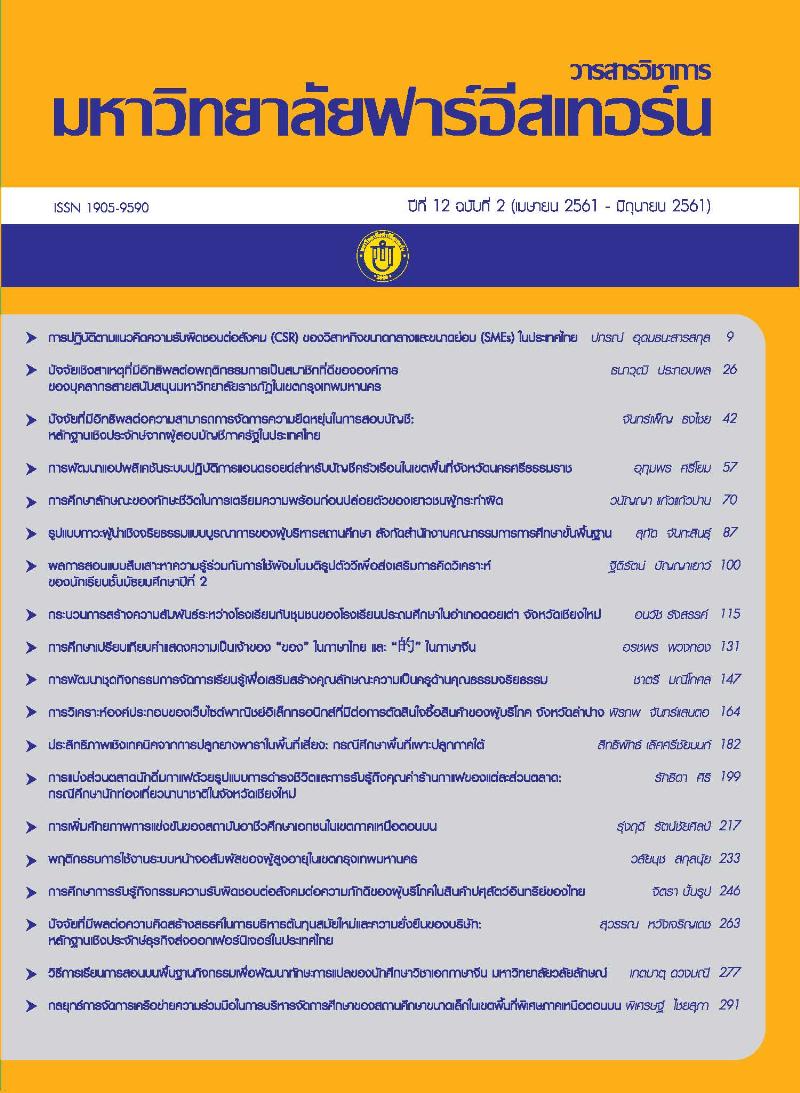Competitiveness Empowerment of Private Vocational Institutions in the Northern Region of Thailand
Main Article Content
Abstract
The purpose of this study were to 1) Study the environmental factors faced by private vocational institutions. 2) Analyze the potential of private vocational institutions and 3) Propose ways to increase the competitiveness of private vocational institutions.
The samples were: Group of Mathayom Suksa 3 in the Northern Region of Thailand 9 students, Group of Prathom Suksa 1 - 3rd Grade of Vocational Education Institutes in the Northern Region of Thailand 9 students, Group of Entrepreneurs in the Northern Region of Thailand 10 people and Group of Scholars in the Northern Region of Thailand 10 people. Use interview form for Focus Group discussion is a tool for collecting information. Then data analyzed by content analysis from the overview to the analysis of sub-topics. The study found that: The student decided to enroll in a private vocational Institutions because they can work and have experience during the course and they want to open up technology courses and industrial development. For entrepreneurs want vocational students to improve their language skills, especially English and Chinese. Including they want to be taught in the Automotive Industry Course. The Competitiveness Empowerment of Private Vocational Institutions in the Northern Region of Thailand is as follows: 1) The Competitiveness Empowerment of marketing competitiveness by Providing Advertising media, public relations, educational institutions to expand market opportunities. 2) The Competitiveness Empowerment of Technological by developing students' potential in technology and testing of quality assessment criteria and 3) The Competitiveness Empowerment of curriculum and programs by enhancing knowledge from speakers who have expertise in future skills and skills as well as language skills.
Article Details
1. Any views and comments in the Journal of Social Innovation and Lifelong Learning are the authors’ views. The editorial staff have not to agree with those views and it is not considered as the editorial’s responsibility.
2. The responsibility of content and draft check of each article belongs to each author. In case, there is any lawsuit about copyright infringement. It is considered as the authors’ sole responsibility.
3. The article copyright belonging to the authors and The Far Eastern University are copyrighted legally. Republication must be received direct permission from the authors and The Far Eastern University in written form.
References
ไทยรัฐออนไลน์. (2558). โรงเรียนอาชีวศึกษาเอกชนในภาวะของการแข่งขัน. สืบค้นเมื่อ 10 มีนาคม 2559, จาก https://www.thairath.co.th/content/187127.
นพดล สุตันติวณิชย์กุล. (2554). การศึกษาความพร้อมด้านเทคโนโลยีของสถานศึกษาอาชีวศึกษาไทยเพื่อรองรับการเป็นการเป็นประชาคมเศรษฐกิจอาเซียน. งานวิจัย. มหาวิทยาลัยธุรกิจบัณฑิตย์.
ปรีชา อุปโยคิน, พลวัฒ ประพัฒน์ทอง, ภัทรา ชลดำรงกุล และ พิมทรัพย์ พิมพิสุทธิ์. (2557). ความต้องการแรงงานและพัฒนาฝีมือแรงงานในอนุภูมิภาคลุ่มแม่น้ำโขง. วารสารมนุษยศาสตร์และสังคมศาสตร์. มหาวิทยาลัยแม่ฟ้าหลวง. มหาวิทยาลัยเกษตรศาสตร์.
เมธาวี สุขปาน. (2556). ปัจจัยที่มีผลต่อการตัดสินใจเลือกศึกษาต่อในหลักสูตรประกาศนียบัตรวิชาชีพขั้นสูง (ปวส.) ของนักเรียน กรณีศึกษาวิทยาพาณิชยการธนบุรี. วิทยานิพนธ์เศรษฐศาสตรมหาบัณฑิต. มหาวิทยาลัยธุรกิจบัณฑิตย์.
รัชนี แก้วเจริญ. (2557). การประเมินการดำเนินงานหลักสูตรประกาศนียบัตรวิชาชีพ ระบบทวิภาคี สาขาวิชาธุรกิจค้าปลีก ของสถานศึกษาอาชีวะเอกชนกลุ่มภาคใต้. วิทยานิพนธ์การศึกษามหาบัณฑิต สาขาวิชาการวิจัยและประเมิน. มหาวิทยาลัยทักษิณ.
เรวดี นามทองดี. (2558). การอาชีวศึกษากับการพัฒนาศักยภาพแรงงานไทยในการเป็นประชาคมอาเซียน ASEAN. วารสารวิชาการ Veridian E-Journal ฉบับสาขามนุษยศาสตร์ สังคมศาสตร์ และศิลปะ ปีที่ 8 ฉบับที่ 2. มหาวิทยาลัยศิลปากร.
วิศาล ภุชฌงค์ และคณะ. (2560X. ปัจจัยที่มีอิทธิพลต่อการเลือกเรียนวิทยาลัยการศึกษาเอกชน: กรณีศึกษา วิทยาลัยเทคโนโลยีพณิชยการลพบุรีเขตอําเภอเมือง จังหวัดลพบุรี. งานวิจัยบริหารธุรกิจดุษฎีบัณฑิต มหาวิทยาลัยปทุมธานี. มหาวิทยาลัยปทุมธานี ศูนย์การศึกษาจังหวัดลพบุรี.
สำนักงานคณะกรรมการการอาชีวศึกษา. (2551). พระราชบัญญัติการอาชีวศึกษา พุทธศักราช 2552. กรุงเทพฯ: กระทรวงศึกษาธิการ.
สำนักงานคณะกรรมการการอาชีวศึกษา. (2556). พระราชบัญญัติการอาชีวศึกษา พุทธศักราช 2552. กรุงเทพฯ: กระทรวงศึกษาธิการ.
สมบูรณ์ กุมาร และฐิตินันท์ กุมาร. (2557). ศึกษาคุณสมบัติของนักบัญชีที่พึงประสงค์ของสถานประกอบการในจังหวัดน่าน. วารสารศรีนครินทรวิโรฒวิจัยและพัฒนา สาขามนุษยศาสตร์และสังคมศาสตร์. ปีที่ 6 ฉบับที่ 12 กรกฎาคม - ธันวาคม 2557.
อัครเดช จำเดิม และ สุดาพร สาวม่วง. (2556). กลยุทธ์การตลาดของสถานศึกษาอาชีวศึกษาเอกชนในประเทศไทย. วารสารวิชาการมหาวิทยาลัยอีสเทิรน์เอเชีย. ปีที่ 3 ฉบับที่ 2 ประจำเดือนกรกฎาคม-ธันวาคม 2556. มหาวิทยาลัยอีสเทิรน์เอเชีย.
อภิชัจ พุกสวัสดิ์ และกุลทิพย์ ศาสตระรุจิ. (2556). การประชาสัมพันธ์ภายใต้กระแสสื่อสังคมออนไลน์. วารสารการประชาสัมพันธ์และการโฆษณา. ปีที่ 6 ฉบับที่ 2.
อดุลย์ จาตุรงคกุล. (2543). กลยุทธ์การตลาด (พิมพ์ครั้งที่ 2). กรุงเทพมหานคร: โรงพิมพ์ มหาวิทยาลัยธรรมศาสตร์.
ไซมอน โชติอนันต์ พฤทธิ์พรชนัน. (2554). จิตวิทยาการตลาด (Psychological factors). สืบค้นเมื่อ 3 สิงหาคม 2554, จาก https://graduate.east.spu.ac.th/graduate/admin/knowledge/A198Psychological.pdf
Anumnu, S. (2014). Knowledge Management and Development of Entrepreneurial Skills Among Students in Vocational Technical Institutions in Lagos, Nigeria. The Electronic Journal of Knowledge Management. 12(2), 144-154.
Holland, John L. (1973). Making Vocational Choice: A Theory o Career. New Jersey: Prentice-Hall.
Hummelsheim, S, and Baur, M. (2014). The German dual system of initial vocational education and training and its potential for transfer to Asia. Prospects, 44, 279-296.
Jackson, J. H, and Hasak, J. (2014). Look beyond the Label: Reframing, Reimagining and Reinvesting in CTE. (Career and Technical Education). American Educator, 14, 34-39.
Kotler, P. (2009). Marketing management. Harlow, England; New York: Pearson/Prentice Hall.
Siano, A., Vollero, A., Confetto, M. G., and Siglioccolo, M. (2013). Corporate communication management: A framework based on decision-making with reference to communication resources. Journal of Marketing Communication, 19(3), 151-167.

